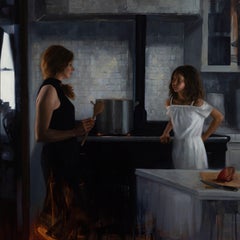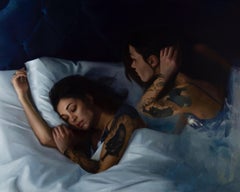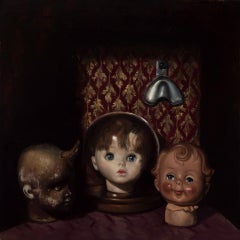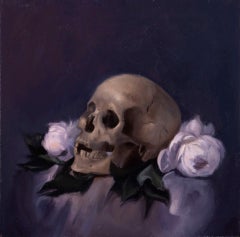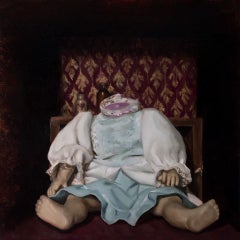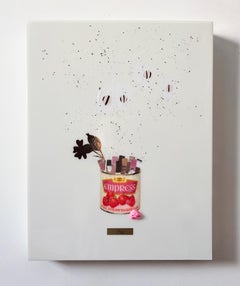Ximena Rendon Art
to
1
8
2
7
1
6
2
Overall Height
to
Overall Width
to
4
4
2
1
1
1
1
1
1
1
1
1
1
1
1
8
8
6,886
3,209
2,514
1,217
8
8
6
2
1
Artist: Ximena Rendon
"Family Recipe (Impossible Soup)" Oil Painting
By Ximena Rendon
Located in Denver, CO
Ximena Rendon's "Family Recipe (Impossible Soup)" is an original, handmade oil painting on aluminum panel that depicts two feminine models inside a kitchen with something cooking on ...
Category
2010s Realist Ximena Rendon Art
Materials
Oil, Panel
"Entre Sueños" Oil Painting
By Ximena Rendon
Located in Denver, CO
Ximena Rendon's "Entre Sueños" is an original, handmade oil painting on aluminum panel that depicts two feminine models inside a bedroom with one appearing to be asleep.
Category
2010s Realist Ximena Rendon Art
Materials
Oil, Panel
Etérea
By Ximena Rendon
Located in Denver, CO
Etérea, 2018
Category
21st Century and Contemporary Ximena Rendon Art
Materials
Panel, Oil
Unlikely Cohorts
By Ximena Rendon
Located in Denver, CO
Unlikely Cohorts
Category
21st Century and Contemporary Ximena Rendon Art
Materials
Wood Panel, Oil
Momento Study
By Ximena Rendon
Located in Denver, CO
Momento Study, 2020
Category
21st Century and Contemporary Ximena Rendon Art
Materials
Oil, Canvas
Forgotten
By Ximena Rendon
Located in Denver, CO
Forgotten
Category
21st Century and Contemporary Ximena Rendon Art
Materials
Oil, Wood Panel
"Beyond, " Oil Painting
By Ximena Rendon
Located in Denver, CO
Ximena Rendon's "Beyond" is an original, handmade oil painting that depicts a lavender hued Bride with a tulle veil turning away.
Category
2010s Realist Ximena Rendon Art
Materials
Oil, Panel
Icarus
By Ximena Rendon
Located in Denver, CO
Mysterious figure in dark landscape
Category
2010s Ximena Rendon Art
Materials
Oil
Related Items
Fabiana : Achy & Ornate
Located in Nashville, TN
This contemporary piece from Danielle Krysa asks the viewer if beauty can be born from the wreckage of whatever each of our personal setbacks may be. The piece was created for Krysa'...
Category
2010s Contemporary Ximena Rendon Art
Materials
Brass
Night Unto Thee
Located in Charelston, SC
Noland Anderson is a self taught portrait artist who strives to create works of art that are a celebration of people of color. Represented by Neema Fine Art Gallery, he is known for his detailed compositions in oils applied with loose brush strokes. He often features images of Black women and men engaging in everyday life in urban settings. Born in Newport News, Virginia with roots in Sumpter, SC, Noland's passion for figure drawing was formed at an early age. Noland attended the Art Institute of Fort Lauderdale where he received an Associate Degree in Advertising. Upon graduating, he went on to work as a freelance illustrator, designing Judaic art...
Category
21st Century and Contemporary Ximena Rendon Art
Materials
Gold Leaf
Careful Sparrow
Located in Charelston, SC
Noland Anderson is a self taught portrait artist who strives to create works of art that are a celebration of people of color. Represented by Neema Fine Art Gallery, he is known for his detailed compositions in oils applied with loose brush strokes. He often features images of Black women and men engaging in everyday life in urban settings. Born in Newport News, Virginia with roots in Sumpter, SC, Noland's passion for figure drawing was formed at an early age. Noland attended the Art Institute of Fort Lauderdale where he received an Associate Degree in Advertising. Upon graduating, he went on to work as a freelance illustrator, designing Judaic art...
Category
21st Century and Contemporary Ximena Rendon Art
Materials
Gold Leaf
Portrait Gentleman Black Coat Orange Sash, Dutch Old Master, Oil on Panel c.1650
By Bartholomeus van der Helst
Located in London, GB
This exquisite portrait of a gentleman depicted in a sumptuous black coat edged with silver and slashed sleeves is an excellent example of the type of portrait fashionable in England and the Low Countries during the 17th century. The confident pose, striking orange sash - the colour of the house of Orange Nassau - and the leather gorget imbue the sitter with a sense of masculinity and power. The profusely decorated costume is of the highest quality and de rigueur of an elite class - the artist has carefully cultivated this portrait to emphasise the sitter’s wealth and standing in the society that he belonged to. The casual pose, with one arm resting on a hip, is much less formal than earlier decades, and it speaks of ‘sprezzatura’ – one’s appearance should not appear laborious, but instead, effortless.
The oil on cradled panel portrait can be dated to circa 1650 based on the hairstyle and the attire - small falling collar, short doublet (doublets reduced in size to just below the ribcage in the late 1650’s), and the type of slashed sleeves with the sleeve seams left open to reveal the white fabric.
The demand for portraits in the Netherlands was great in the 17th century. Bartholemeus van der Helst was considered to be one of the leading portrait painters of the Dutch Golden Age surpassing even Rembrandt as the most sought-after portraitist in Harlaam. The Dutch Golden Age, roughly spanning the 17th century, was a period when Dutch trade, science, military, and art were among the most acclaimed in the world. Dutch explorers charted new territory and settled abroad. Trade by the Dutch East-India Company thrived, and war heroes from the naval battles were decorated and became national heroes. During this time, The Dutch Old Masters began to prevail in the art world, creating a depth of realistic portraits of people and life in the area that has hardly been surpassed. The Golden Age painters depicted the scenes that their discerning new middle-class patrons wanted to see. This new wealth from merchant activities and exploration combined with a lack of church patronage, shifted art subjects away from biblical genres. Still life’s of items of everyday objects, landscapes, and seascapes reflecting the naval and trade power that the Republic enjoyed were popular. The new wealthy class were keen to have their portraits commissioned and many artists worked in this lucrative field. Such was the popularity of art that everyone had a painting, even the humble butcher, and hundreds of thousands of paintings were produced.
By tradition the sitter is Maarten Tromp (1598-1653) who was an Admiral in the Dutch Navy (the reverse of the portrait contains an old handwritten inscription “van Tromp”). Certainly, the distinctive orange sash is similar to those worn by officers of the Dutch army in the Netherlands who served under the Princes of Orange and the House of Nassau. However, it should be noted that the physiognomy differs from other images of Tromp.
Tromp was the oldest son of Harpert Maertensz, a naval officer and captain. He joined the Dutch navy as a lieutenant in July 1622 and was later promoted from captain to Lieutenant-Admiral of Holland and West Frisia in 1637. In 1639, during the Dutch struggle for independence from Spain, Tromp defeated a large Spanish fleet bound for Flanders at the Battle of the Downs, which marked an enormous change - the end of Spanish naval power. He was killed in action during the First Anglo-Dutch War in 1653 where he commanded the Dutch fleet in the battle of Scheveningen.
Gloves were an absolutely vital accessory and the elaborate pair in this portrait are embellished with threads of silk and precious metals and salmon-coloured lining. He wears only one glove and holds the other, providing an opportunity to better display the cuffs and detail on his right wrist and forearm. The gloves are probably made from the most prized leather which came from Spain, in particular from Cordova. Cordovan leather was tanned with a special vegetal process that left it both highly impermeable and divinely soft. King Charles I, posed in a rather relaxed manner for Daniel Mytens’s portrait in 1631, is wearing gloves and boots in matching Cordovan leather. The hide is thick, but you can see just how supple it is from the way the gauntlet dimples and the long boot legs fold over themselves, rippling and wrinkling at the ankles.
Apart from keeping hands warm the use of gloves during the 15th through the 19th centuries were full of symbolism and they were worn regardless of the season. They kept the skin unblemished - soft, smooth hands were considered highly attractive. This combination of necessity and proximity to bare skin made gloves a deeply personal gift and they took on a strong symbolic significance and were regarded as emblematic of fidelity and loyalty for hundreds of years. Such was the importance of their symbolism was that some gloves were never intended to be worn at all. Their luxury made them ideal gifts at court, and so in the 15th and 16th centuries, ambassadors often presented them as symbols of loyalty.
Until the mid-19th century, it was customary to give gloves as tokens to guests at weddings and to mourners at funerals. Gentleman often gifted their bride-to-be with a pair of gloves (the obligatory gift) and were handed over at the betrothal and put on display before the wedding took place. It was probably their direct contact with the skin that led to the eroticism of gloves. Not only were pairs often exchanged between lovers, but from the 16th to the 18th centuries, it was common practice to remove one glove and give it as a gift to a favourite. The idea of the item being presented still warm from the wearer’s hand is certainly suggestive. Following the death of King George IV, his executors purportedly found over a thousand mismatched ladies’ gloves among his possessions.
The sentiment of a 17th-century poem reveals the popularity of the practice: “Come to our wedding to requite your loves / Shew us your hands and we’ll fit you with gloves.” Such generosity might be pricey for the hosts, but gloves of varying quality could be offered depending on the status of the recipient. Pairs made with the finest Spanish leather might be reserved for immediate family, while coarse sheep’s leather could be distributed among the servants and tradesmen. The apportioning of quality according to class provided a very clear message of the gloves’ intended use. For refined guests, they were decoration; for the lower classes, they were functional.
Bartholomeus van der Helst...
Category
17th Century Old Masters Ximena Rendon Art
Materials
Oil, Wood Panel
H 38.59 in W 31.89 in D 2.76 in
Portrait of a Newfoundland dog, William Smith, British Painting, 1838, Pets Art
Located in Greven, DE
The works of William Smith were regularly exhibited at the Royal Academy in London between 1813 and 1859. Yet little is known about this artist. He lived in Shropshire and was active...
Category
19th Century Romantic Ximena Rendon Art
Materials
Canvas, Oil
Portrait of a Lady Diana Cecil, Countess of Elgin c.1638, Manor House Provenance
Located in London, GB
Titan Fine Art present this picture which formed part of a historic collection of an English aristocratic family, Lord and Lady Sandys at their magnificent baroque and Regency Grade-...
Category
17th Century Old Masters Ximena Rendon Art
Materials
Oil, Wood Panel
H 18.9 in W 16.15 in D 1.58 in
"Night Murmurs, " Oil Painting
By Mia Bergeron
Located in Denver, CO
Mia Bergeron's (US based) "Night Murmurs" is an original, handmade oil painting that depicts a man in a dark interior room with a yellow lamp lit on his bedside table.
Mia Bergeron...
Category
2010s Realist Ximena Rendon Art
Materials
Oil
Odalisque - Woman in a Harem - French 1900 Orientalist art portrait oil painting
By Lucien Laurent Gsell
Located in London, GB
This charming ex Christie's Victorian Orientalist oil painting is by noted French exhibited artist Lucien Laurent Gsell. The painting dates to around 1900 and portrays a beautiful yo...
Category
Early 1900s Realist Ximena Rendon Art
Materials
Oil
Italian genre portrait Middle Eastern beauty at a well 19th century oil painting
Located in Stockholm, SE
Bedouin girl posing for the painter in late sunlight (sunset). Was painted by Cavaliero Antonio Scognamiglio ca. 1870-1880, most likely in Cairo as similar work of smaller size was i...
Category
Late 19th Century Realist Ximena Rendon Art
Materials
Canvas, Oil
Free Shipping
H 30 in W 19 in
"End Stop" Contemporary Abstract Gray and Green Concentric Circle Painting
Located in Houston, TX
Gray and green abstract contemporary concentric circle painting by Houston, TX artist David Hardaker. Signed, titled, and dated by the artist on the reverse.
Artist Statement: The w...
Category
2010s Contemporary Ximena Rendon Art
Materials
Oil, Panel
H 45 in W 26.5 in D 1.75 in
"Paradox" oil painting, female nude, drapery, leaf motifs
By Lauren Rinaldi
Located in Philadelphia, PA
This female nude piece titled "Paradox" is an original artwork made from oil on panel by Lauren Rinaldi. This piece measures 24”h x 18”w.
Lauren Rinaldi (b. 1983, Brooklyn, NY) is a...
Category
21st Century and Contemporary Contemporary Ximena Rendon Art
Materials
Panel, Oil
Reflections of Contemplation by German Artist Karl Weise, Candle Light Genre
Located in Stockholm, SE
This painting features a young girl sitting on a chair in a dimly lit room, illuminated by the soft glow of an orange-tinted ceiling lamp. This painting captures the essence of the candle-light genre of art, which originated in the 17th century and was popularized by Dutch and Flemish artists.
The candle-light paintings were characterized by the use of a single source of light, which was usually a candle, and were often accompanied by the inclusion of reflective surfaces such as mirrors, to create an ambiance of warmth and intimacy. Weise's painting is a beautiful example of this genre, as he uses the same technique of a single source of light to create a sense of depth and realism in the painting.
The girl in the painting is dressed in a vibrant red dress and white stockings, and her expression suggests a moment of contemplation. On the table, there is a photo frame, perhaps containing a picture of someone dear to her, and its reflection is visible in the mirror in the background. The piano on the right side of the painting is in shadow, while above it is a portrait painting with a golden frame, which adds to the ambiance of the room.
Karl Weise was a renowned painter known for his exceptional use of light and shadow in his paintings, which created a mesmerizing play of light that evoked a sense of depth and realism in his work. His paintings were highly appreciated during his lifetime, and they continue to be admired today for their timeless beauty and artistic merit.
In conclusion, Karl Weise's painting is a beautiful example of the candle-light genre of art. The use of a single source of light creates a warm and intimate ambiance, while the shadows add depth and dimension to the painting. The young girl's expression and the inclusion of the photo frame and portrait painting add a sense of storytelling to the painting, making it a truly captivating classic artwork...
Category
1910s Realist Ximena Rendon Art
Materials
Oil, Canvas
Ximena Rendon art for sale on 1stDibs.
Find a wide variety of authentic Ximena Rendon art available for sale on 1stDibs. You can also browse by medium to find art by Ximena Rendon in oil paint, paint, panel and more. Not every interior allows for large Ximena Rendon art, so small editions measuring 5 inches across are available. Customers who are interested in this artist might also find the work of Cristian Mesa Velazquez, Matthew Alfonso Durante, and Maite Backman. Ximena Rendon art prices can differ depending upon medium, time period and other attributes. On 1stDibs, the price for these items starts at $400 and tops out at $5,500, while the average work can sell for $700.
